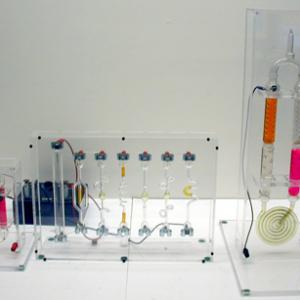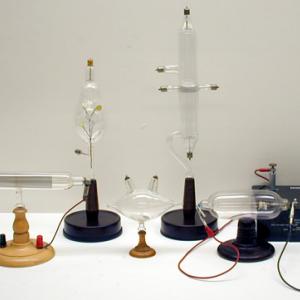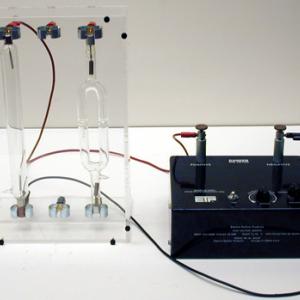College of Liberal Arts & Sciences
5M20.20 - Geissler Tubes and Special Discharge Tubes
These tubes are the only functional Geissler tubes. The other Geissler tubes have lost their vacuum and were filled with colored water for show purposes.
Hook an induction coil to the two tubes at the electrodes. Turn on the coil and adjust the power. The liquids in the tubes are fluorescent and will give some interesting colors.
The new set of small Geissler tubes will work with either the induction coil or one of the Tesla coils. These are designed to show different patterns of electrical discharge.
NOTE: Be careful when using the tubes with the table top Tesla coil as it is powerful enough to burn them out if it is turned too high.
All of these tube work in the same general fashion, ie: Hook the induction coil to the electrodes of the tube, turn on and adjust the power and the direction of the current of the coil.
- Nicholas R. Guilbert, "Shedding Some Light on Fluorescent Bulbs", TPT, Vol. 34, # 1, p. 20- 22, Jan. 1996.
- Carl Fields, "Radiation From Video Display Terminals?", TPT, Vol. 25, # 4, p. 213, April 1987.
- Thomas B. Greenslade, Jr., "Geissler Tube with Fluorescent Flowers", AJP, Vol. 90, #6, June 2022, p. 415.
- Thomas B. Greenslade, Jr., "Geissler Tube Mounted on a Rotator", AJP, Vol. 89, #3, March 2021, p. 299.
- S-150: "Gas Discharge & Evacuated Tube", DICK and RAE Demo Notebook.
- A-12, 13: Richard Manliffe Sutton, Demonstration Experiments in Physics.
- George M. Hopkins, "Frictional Electricity", Experimental Science, p. 380.
- George M. Hopkins', "Geissler's Tubes", Experimental Science, Volume Two, p. 43.
- R. W. Pohl, "Some Applications of Independent Conduction in Gases at Low Pressure", Physical Principles of Electricity and Magnetism, p 218.
- Gary Kessler, "Recycle Outmoded Air-Track Components", Apparatus for Teaching Physics, p. 236, Edited by Karl Mamola.
- Julien Clinton Sprott, "4.8, Gas Discharge Tube", Physics Demonstrations, p. 200, ISBN 0-299-21580-6.
- Gerard L'E Turner, "Electric Discharges in Gases", Nineteenth-Century Scientific Instruments.
- Ron Hipschman, "Glow Discharge", Exploratorium Cookbook III, p. 145.1 - 145.4.
- The Queen Catalogues Vol. I, Catalogue of Instruments used in Physical Optics, p. 63.
- The Queen Catalogues Vol. II, Catalogue of Physical Instruments, Section XV, p. 111.
Disclaimer: These demonstrations are provided only for illustrative use by persons affiliated with The University of Iowa and only under the direction of a trained instructor or physicist. The University of Iowa is not responsible for demonstrations performed by those using their own equipment or who choose to use this reference material for their own purpose. The demonstrations included here are within the public domain and can be found in materials contained in libraries, bookstores, and through electronic sources. Performing all or any portion of any of these demonstrations, with or without revisions not depicted here entails inherent risks. These risks include, without limitation, bodily injury (and possibly death), including risks to health that may be temporary or permanent and that may exacerbate a pre-existing medical condition; and property loss or damage. Anyone performing any part of these demonstrations, even with revisions, knowingly and voluntarily assumes all risks associated with them.



